
ShellBlack is celebrating its 15-year anniversary, so it seems appropriate to share how it all started, as well as some key decisions (and mistakes) made along the way that have shaped our success.
A little background first …
I was introduced to Salesforce in 2005 by a former boss and mentor who had started a Salesforce consulting practice. Salesforce was only six years old at that point, and web-based applications were a new frontier. I was coming from a business world that revolved around spreadsheets or software somewhere on a server, and the idea that you could create business processes, track analytics, and modify a database through a web browser was mind-blowing. I joined his consulting firm, learned Salesforce, and delivered dozens of projects over the course of two years.
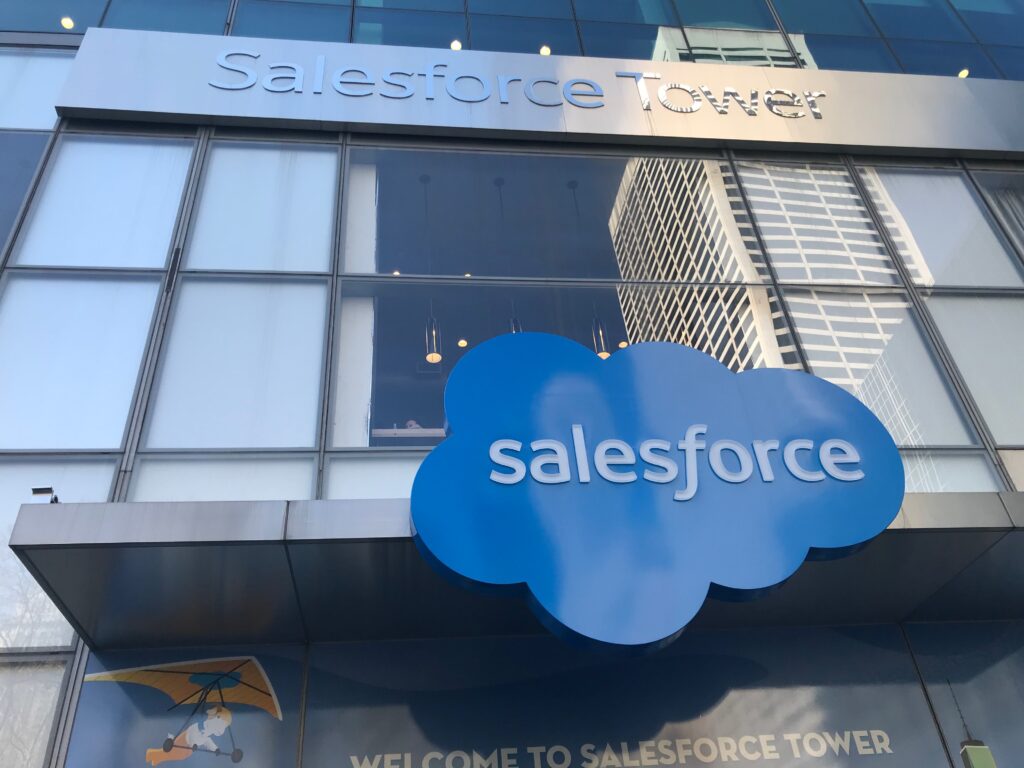
At the end of 2006, I got a job offer from a finance company that was too good to refuse. They didn’t have Salesforce, but that would quickly change. Sometime, maybe late into my first year with this company, a project hit my desk that I knew would be a good use case for Salesforce. I spun up a developer account over the weekend and created a proof of concept. I pitched it to the CEO on a Monday; by Friday, the firm was a Salesforce customer.
As a consultant, I only witnessed companies getting started with Salesforce. Always off to my next client project, I never got to see my clients grow. Now, as a customer, I was constantly architecting solutions and building functionality, year after year. And build I did. We had Salesforce connected to our website; we had custom integrations to both internal systems and third-party data providers — we even had a Self-Service Portal (SSP). If you’re wondering, the SSP was the precursor product to Experience Cloud. Word got out in the company about what I was doing with Salesforce, and departments sought me out for help as they got tired of waiting on traditional IT support.
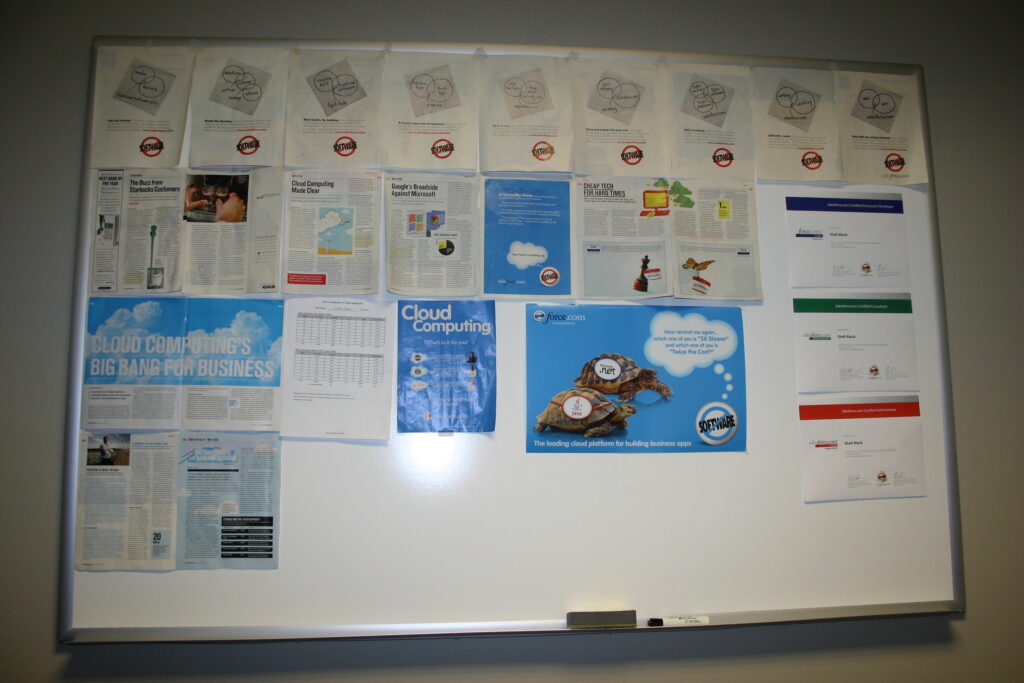
A picture of my office wall showing Salesforce ads and the Salesforce certifications I had earned.
Bad news — what’s next?
Everything seemed to be going great until I received some disappointing news in early 2010. The CEO let me know that, after four years of aggressively building out Salesforce, he felt that too much of the company was dependent on the technology. As the Salesforce administrator, my efforts were put on hold.
Now, faced with the reality that my Salesforce role was coming to an end, I felt all the knowledge I had gathered over the last five years might go to waste. I wanted to keep learning. I already had multiple Salesforce certifications, but the platform was evolving quickly, and I didn’t want to fall behind.
I had seen the first early glimmers of the Salesforce community starting to bud on Twitter and on a few personal blogs, and I desperately wanted to connect with others who were equally excited about Salesforce. So, in mid-June of 2010, I created ShellBlack.com. It was not conceived as a business; it was simply my personal blog — an outlet for me to write about all the cool tips and tricks I had learned thus far on my Salesforce journey.
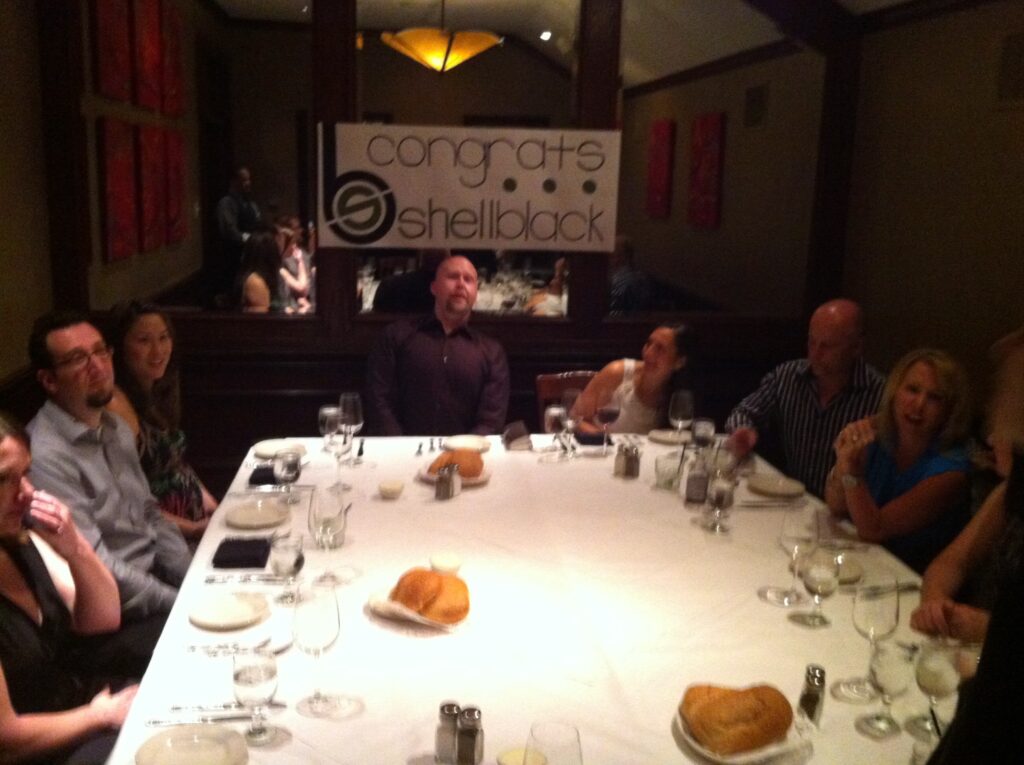
Official ShellBlack.com kick off party!
Accidental entrepreneur
Then something unexpected happened. Businesses started to reach out to me asking if I could help them with Salesforce. Keep in mind, back in 2010, the platform was not as ubiquitous as it is now. It was much easier to stand out and be found in the early days — unlike today, when there are 3,000 Salesforce partners.
While keeping my full-time job, I started doing outside consulting. Yep, I started a side hustle. It was fun, exciting, and maybe even a little intoxicating. I remember sitting at the kitchen table creating my first proposal template — quite the creative writing exercise.
In 2011, I had three contractors to help with the workload. By early 2012, I was seriously considering leaving my day job to consult full-time but was held back by the security blanket of direct deposit and health insurance. In May 2012, that decision was made for me when I was let go. I wasn’t totally surprised, as I’m sure it was clear that I had a business on the side. All you had to do was Google my name to see what I was up to.
This was the decision point: either double down and be an entrepreneur or go back to the safety of a corporate job. It wasn’t an easy decision, as my wife had just stopped working and I had a kid in private school, a mortgage, a balance on my credit cards, and suddenly no health insurance. Somehow, I convinced my wife that it was time to see what I could do, and to her credit, she had trust that we would make it.
A few weeks after being fired, I vividly remember sitting in a hotel room in Chicago having a bit of a mental freak-out. The next morning, I was going to train end-users to support one of my early clients going live on Salesforce. Maybe it was “impostor syndrome,” but I had to give myself a serious pep talk that this was all going to work out.
And work out it did. We grew to 10 contractors by the end of 2012. In retrospect, I was working an insane, and very unhealthy, number of hours week after week. But, as I was building the company, every bit of work that I personally delivered went straight to the bottom line. I was doing everything — marketing, sales, delivery, accounting, you name it. I was wearing every hat imaginable. And that hard work paid off — we continued to grow.
When I had no more calendar capacity for sales calls, I hired a salesperson. When I could no longer have everyone report to me, I moved people into manager positions. Every year, if not every few months, we had new positions, new people, new roles — operations, marketing, HR — and a new org chart. We were on our way, and as they say, I slowly stopped working in the business and started working on the business.
ShellBlack Whiteboard
In the early years, every spare minute I had (which wasn’t many), was spent creating content. This was still before there were a bazillion TrailBlazers spewing content everywhere you looked.
I can’t remember exactly what made me think of trying to use video as a channel to express myself, broadcast what I knew about Salesforce, and promote ShellBlack, but I was one of the first to put out meaningful Salesforce content on YouTube. There were a couple of things that influenced the creation of ShellBlack Whiteboard. I was an instructor for Salesforce for a brief time and had delivered around 20 instructor-led classes across the United States. I also found while consulting that I was constantly explaining to my clients how Salesforce worked. This experience of teaching and explaining the fundamentals of Salesforce was the catalyst for the Whiteboard series. I had an old employee who used to tease me by saying something like, “Shell is the only one who can make lead conversion interesting.”
The production of ShellBlack Whiteboard was probably more low-tech than people realized. I was still bootstrapping the company. I’d rent a studio at a local tech school for the day — off-hours, on the weekend — and students would receive class credit for setting up and filming. I literally bought a whiteboard and had it delivered to the school and showed up with a “script” for four to six videos that I wanted to shoot that day. The script was just an outline that was transferred to the whiteboard, which became my cue card of what to say next when the camera was rolling. We’d make one or two takes, then I’d erase the whiteboard and set up for the next episode. I wore the same outfit every time. (I called it my “Mr. Rogers uniform.”)
All together, I made about 30 videos. Luckily, everything on ShellBlack Whiteboard was concept-based rather than screenshot-dependent, which would have quickly become outdated when the Lighting UI rolled out. The video series was a hit. I can’t tell you how many times I’d get stopped at Dreamforce and someone would say, “Hey, you’re the Whiteboard guy!” I looked at the YouTube stats recently, and the Whiteboard series has had over 2 million minutes watched. It still gets traffic, although 80% of views occurred before Trailhead scaled up. Once Trailhead was well-established, people didn’t have to search the far corners of the web for Salesforce training. With the decrease in traffic, I made a decision to shelve the Whiteboard series.
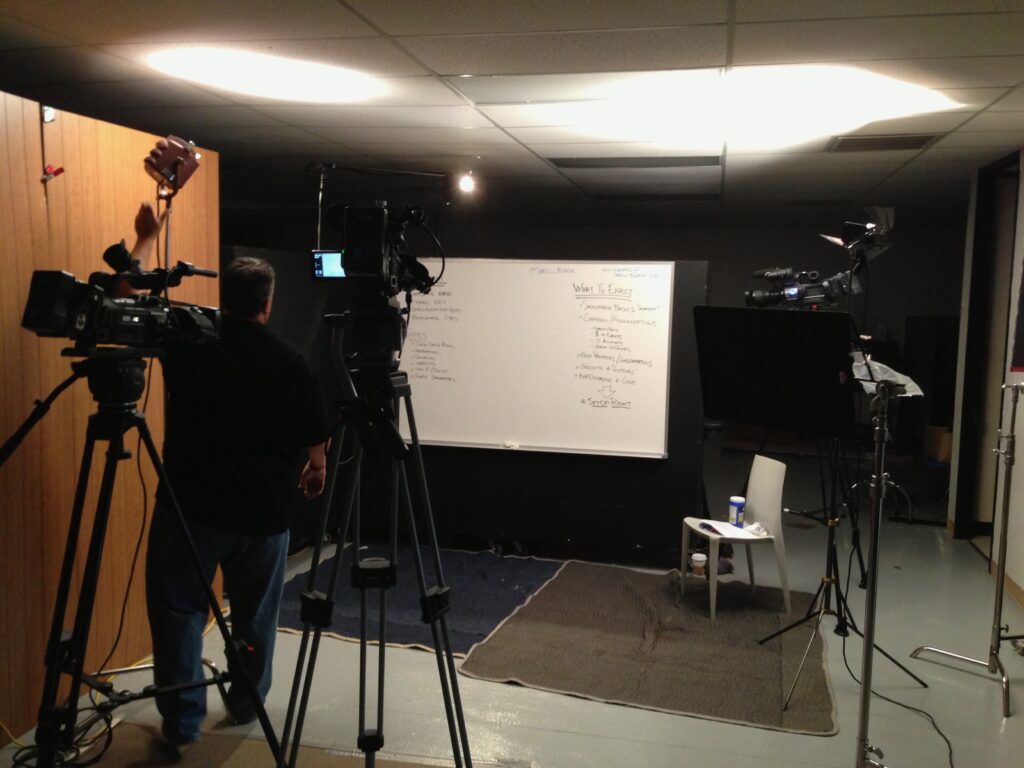
Behind the scenes of the ShellBlack Whiteboard series filming
Dreamforce speaker
About three years into my ShellBlack journey, around 2013, I began speaking and presenting sessions at Dreamforce. Selfishly, I was there to stand on a stage and demonstrate expertise in hopes of finding new clients. Though not always successful, it gave my personal brand and company credibility. Dreamforce was always a physically exhausting week. I’d stress out about these presentations. I was constantly overscheduled at Dreamforce. And though there were inevitably late nights socializing and networking, I’d get up crazy early and rehearse my presentations over and over again in my hotel room. I spoke at Dreamforce for six years in a row.
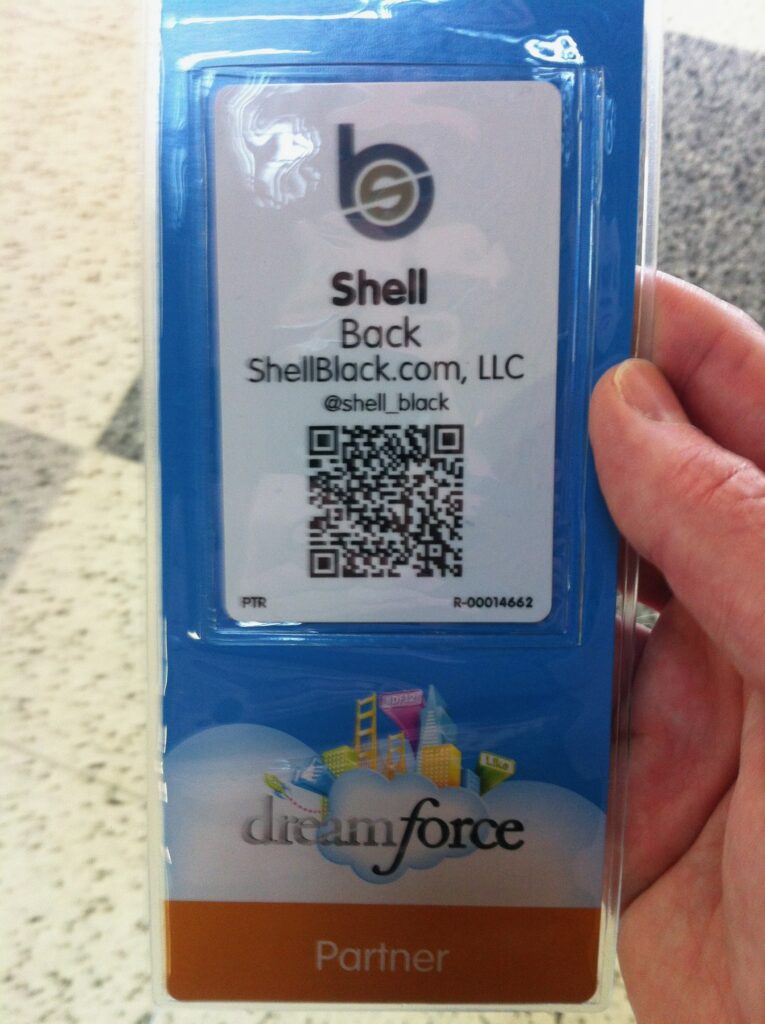
My first Dreamforce badge
Endless self-promotion
I made a concerted effort to get the ShellBlack brand out there. I wrote articles for different online publications, spoke at community events, appeared on Salesforce podcasts, and posted on social media channels. I was always hustling, always trying to promote ShellBlack.
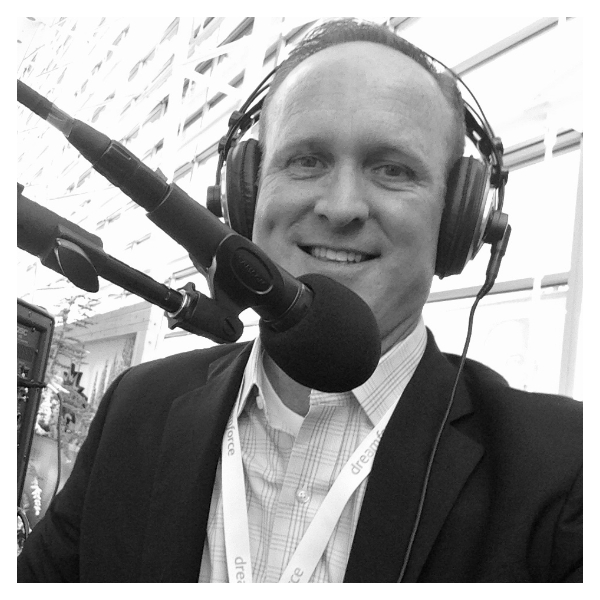
https://www.shellblack.com/media/
Becoming a Salesforce MVP
I believe my 150+ blog posts and 30+ Whiteboard videos contributed the most to my becoming a Salesforce MVP in November 2012. The program was only two years old at that point — so very early days. What’s a Salesforce MVP? Today, we’d call them Salesforce influencers, but “influencer” wasn’t a term we used back then. MVPs are the top 1% of the content creators in the Salesforce community. They are brand evangelists as well as product specialists. When I was inducted, there were probably only 30 or so MVPs. A decade after the program was launched, there are now hundreds of MVPs around the world.
The early days of the MVP program were incredible. We had unbelievable access to Salesforce leadership and product managers, and we could network and connect with the best and brightest in the Salesforce ecosystem. At Dreamforce, we were treated like celebrities; we received free passes, exclusive access, and reserved seating at keynotes, and usually one hell of a party.
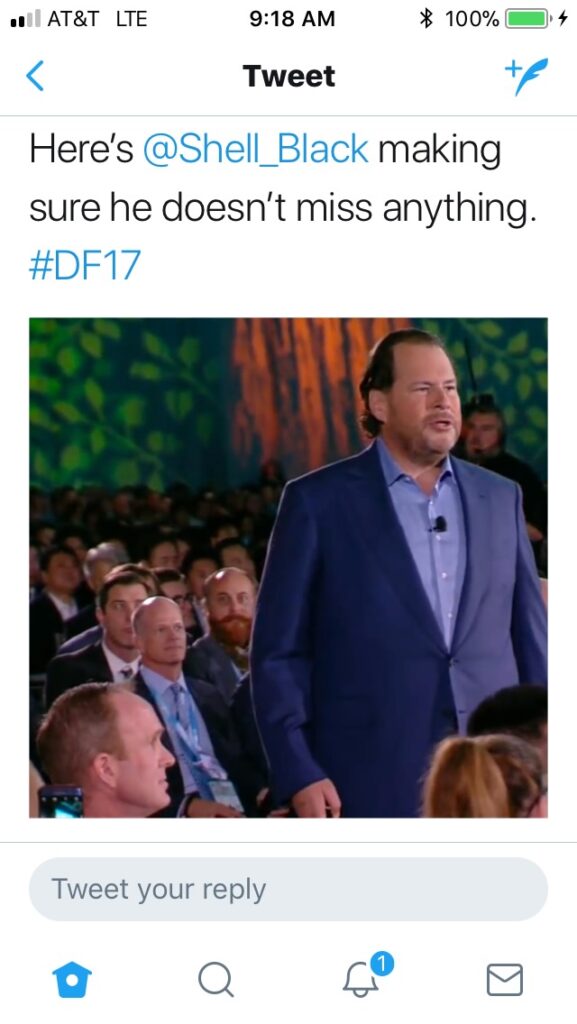
Here I am enjoying an MVP perk during the Dreamforce keynote with Marc Benioff!
I was an active MVP for seven years, and when the Salesforce MVP Hall of Fame program rolled out, offering Dreamforce perks without the demands of active status, I gladly accepted the honor in August of 2019. I had done my time in the spotlight and worked very hard to keep my MVP status by contributing my time mentoring, speaking, and creating content — but ShellBlack was continuing to grow, and I found myself having to spend more time running the business and less time being hands-on with the product.
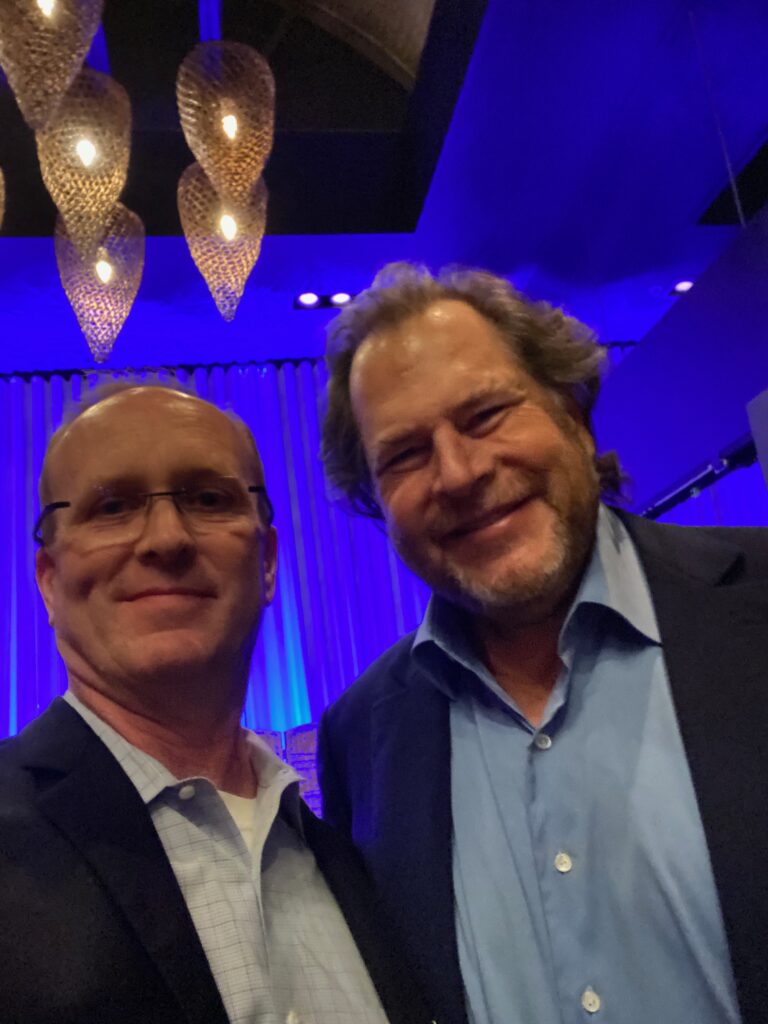
Selfie with Marc Benioff
Riding the wave
If you look at the big picture, growth was steady for ShellBlack for 10 years. Part of that was obviously a lot of hard work, but part of that was also Salesforce growing at an insane pace — like 20-25% YoY growth. There was a gold rush of partners and consultants entering the ecosystem during this time to meet the demands of new Salesforce customers. Competition grew each year. There were more and more partners chasing fewer and fewer deals from Salesforce. But there was another headwind — the platform was growing faster than an invasive weed, organically and through acquisitions.
The need to specialize
When I started, there were only three Salesforce products — Sales Cloud, Service Cloud, and Communities (now called Experience Cloud). Salesforce had made acquisitions in the past, but around 2015, the pace seemed to be accelerating. As of today, Salesforce has closed more than 60 deals. I could see that ShellBlack was going to have a hard time if we didn’t specialize. There were too many new products. If we tried to “do it all,” we’d be good at nothing and average (or worse) at everything.
At the end of 2015, I could also see that Salesforce was getting serious about industry verticals with the announcement of Financial Services Cloud (FSC). This was the second reason I decided to “pick a lane” and focus the business on financial services. Probably not surprising, since I had worked for a finance company before starting the consulting business. Also, ShellBlack already had a strong portfolio of financial services customers.
Additionally, we landed an important wealth firm that arguably became one of the top players in the registered investment advisor (RIA) space. Over seven years, we grew as they grew. Through osmosis and millions of dollars of project work, we learned an incredible amount about wealth management. This one client experience would set us on a course that would ultimately lead us to be the leading Salesforce partner in wealth management. To that client, a special thank you for your trust and support.
Within a few years, the course was set to become a financial services (FINS) specialist. We redesigned our website to appeal to a financial services audience. The more work we did in the space, the more our knowledge and FSC expertise expanded. Our referral base grew, our customer base grew, and our relationships at Salesforce that focused on FINS grew. By the early 2020s, 95% of our active customer base was in FINS.
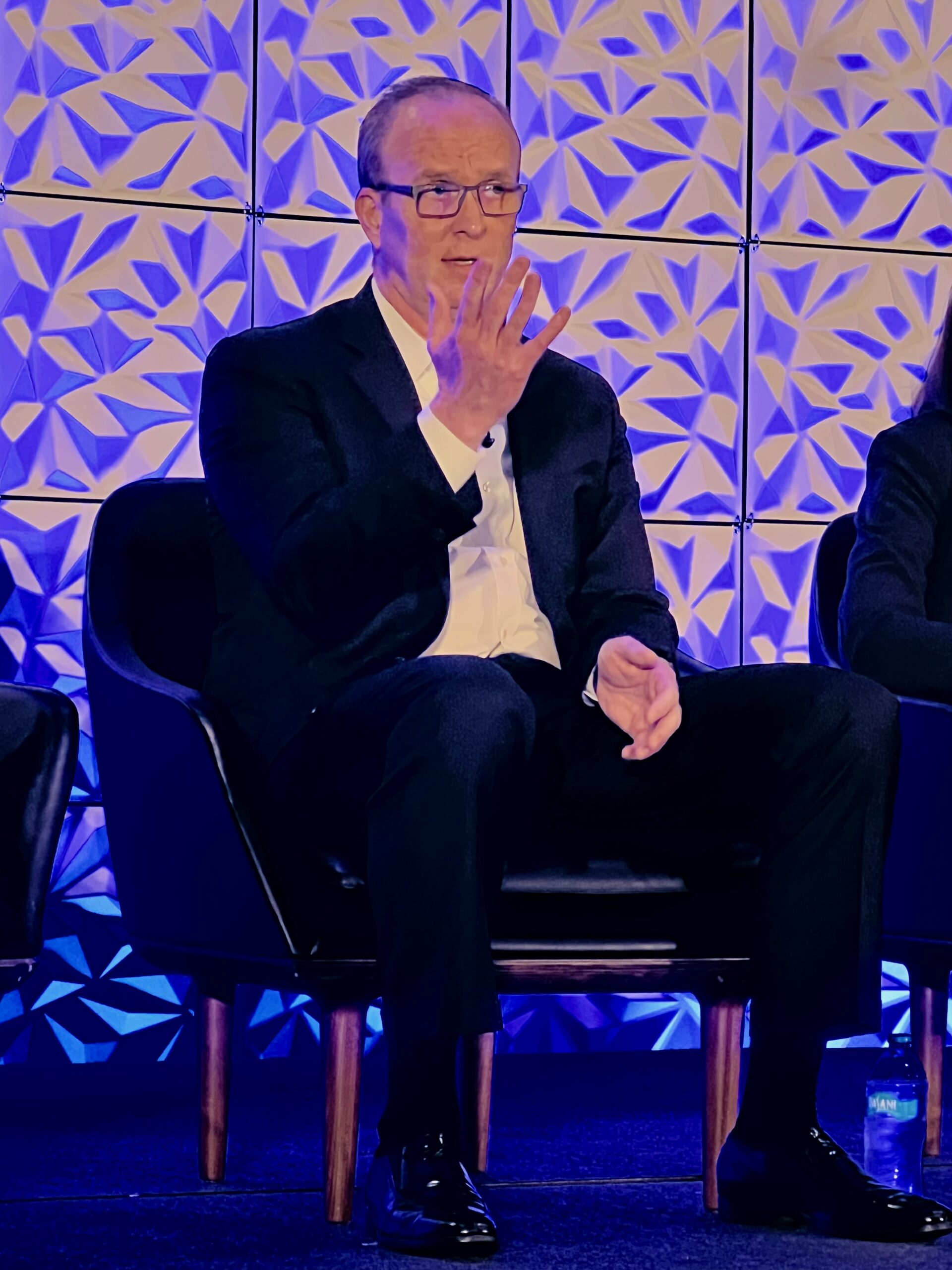
Panelist at the DeVoe Elevate conference, sharing insights with industry peers.
Birth of the ShellBlazer
Thanks to COVID-19, 2020 was a challenging year, as I’m sure it was for many companies. Companies that were forced to work from home soon realized they needed a cloud-based customer relationship management (CRM) platform that would allow them to work outside the office. Because of this, business was brisk for Salesforce, and the demand for Salesforce talent was at an all-time high. It seemed like every Salesforce partner was hiring to try and keep up. The competition for consultants was fierce. We had scaled to the point where we had exhausted our networks, and almost overnight, started spending tens of thousands of dollars on LinkedIn advertising, trying to fill open positions. We even hired a fractional recruiter.
That year, I learned so much about what we were doing right and what we needed to improve or change. During this time, I was active in Entrepreneurs’ Organization (EO) and discovered Culture Index. Culture Index was transformative to ShellBlack in defining what personalities could swim in different roles, and which would sink. We embraced Culture Index and had everyone in the company surveyed to identify their profile. We sent the leadership team to training to not only help with interviewing and candidate screening, but also to learn how to best communicate with each other. In our experience, it’s been 100% on point. Using Culture Index for candidate screening, and getting the right people in the right roles, was a huge step forward — but it didn’t solve everything.
When you’re growing, you think you have a good culture and solid company values. In retrospect, we hadn’t defined either of those. Why would someone want to join us? What makes us different? Who do we want working for us? The year after the COVID-19 pandemic, we spent a lot of time asking ourselves these questions — and to some degree we haven’t stopped asking. We took a step back and rede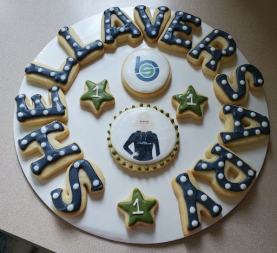 fined our Core Values. We created the ShellBlazer program. Everyone got a custom-created ShellBlazer avatar. We allocated tens of thousands of dollars to quarterly appreciation events (QAEs) to regularly bring the team together. We created 1-, 3-, 5-, and 10-year “Shellaversaries” that provide items like awards, personalized gifts, and even extra paid time off.
fined our Core Values. We created the ShellBlazer program. Everyone got a custom-created ShellBlazer avatar. We allocated tens of thousands of dollars to quarterly appreciation events (QAEs) to regularly bring the team together. We created 1-, 3-, 5-, and 10-year “Shellaversaries” that provide items like awards, personalized gifts, and even extra paid time off.
Other factors contributed to defining our culture. We defined a career path for our consultants, and subsequently changed it after the first attempt didn’t hit the mark. We tweaked compensation plans to put team members 100% in control of their annual increases and bonuses. At ShellBlack, key performance indicators cannot be subjective and cannot be tied to something out of the team member’s control, like company growth. I believe it was also about that time we decided to contribute to each employee’s 401(k) plan, regardless of whether the employee was making contributions.
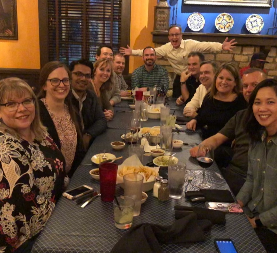
Lastly, we put our culture out there for all to see — on our LinkedIn company page and our website — because we could finally be proud of it. I guess you could say we no longer take our culture for granted. It became deliberate.
Time to reflect, celebrate, and acknowledge
Fifteen years! As you can imagine, it’s been a wild ride. There were other twists and turns, ups and downs, but in the need for brevity, I’ll stop here. As I conclude, I want to recognize the countless contributions of so many that made us who we are today — our amazing customers, team members (past and present), our partners, and, of course, Salesforce. Thank you from the bottom of my heart for shaping us into who we are today.
-Shell Black, founder and president